Lohja
Lohja (Finnish pronunciation: [ˈlohjɑ]; Swedish: Lojo) is a city and municipality in the Uusimaa region of Finland. The city has a population of 47,518 (2017),[2] and it covers an area of 1,109.73 square kilometres (428.47 sq mi) of which 91.78 km2 (35.44 sq mi), or 8.3 percent, is water.[1] The population density of Lohja is 130.73 inhabitants per square kilometre (338.6/sq mi). The municipality is bilingual, with the majority being Finnish and minority Swedish speakers.[3] Lohja has the fourth-most summer houses of any municipality in Finland, with 8,468 located within the city as of June 2018.[5] Lohja is located near Greater Helsinki, and it benefits from a good road network. It takes less than an hour to drive from Helsinki to Lohja on the E18 motorway, which is one of the most significant main road connections in Lohja next to Hangonväylä.
Lohja
Lohja – Lojo | |
|---|---|
City | |
| Lohjan kaupunki Lojo stad | |
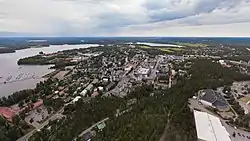 | |
 Coat of arms | |
| Motto: Järvikaupunki - Insjöstaden | |
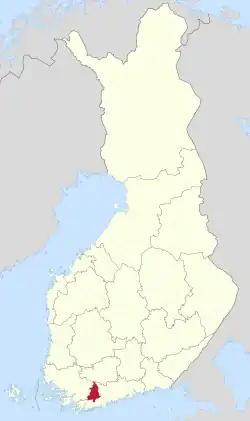 Location of Lohja in Finland | |
| Coordinates: 60°15′N 024°04′E | |
| Country | |
| Region | Uusimaa |
| Sub-region | Helsinki sub-region (formerly Lohja sub-region) |
| Charter | 1926 |
| City rights | 1969 |
| Government | |
| • City manager | Pasi Perämäki |
| Area (2018-01-01)[1] | |
| • Total | 1,109.73 km2 (428.47 sq mi) |
| • Land | 349.41 km2 (134.91 sq mi) |
| • Water | 91.78 km2 (35.44 sq mi) |
| • Rank | 82nd largest in Finland |
| Population (2023-10-26)[2] | |
| • Total | 45,677 |
| • Rank | 25th largest in Finland |
| • Density | 130.73/km2 (338.6/sq mi) |
| Population by native language | |
| • Finnish | 90.9% (official) |
| • Swedish | 3.5% |
| • Others | 5.6% |
| Population by age | |
| • 0 to 14 | 15.8% |
| • 15 to 64 | 59.5% |
| • 65 or older | 24.7% |
| Time zone | UTC+02:00 (EET) |
| • Summer (DST) | UTC+03:00 (EEST) |
| Climate | Dfb |
| Website | www.kaupunki.lohja.fi |
City's bilingual slogan is: Järvikaupunki - Insjöstaden which translates to "Lake city".[6]
The landscape of Lohja is characterized by manors and gardens. Its area is divided by the Lohja ridge, which forms a watershed for the largest lake system in Uusimaa, Lake Lohja (Lohjanjärvi); mostly that's why Lohja is also referred to as "Lake City" (järvikaupunki).[7] The medieval Church of St. Lawrence is the architectural highlight of downtown Lohja, which also includes a heterogeneous mix of buildings mostly dating from the 1960s onwards. The Lohja library, which was opened in 2005, is a distinctly modern building placed in the very centre of the city.
Lohja has been a focal point for the population and economy of western Uusimaa since the early 14th century. It was renowned as a trading centre in the Middle Ages. The local inhabitants were among the pioneers of the Finnish mining and construction material industries. Lohja has long-established traditions in horticulture and especially in market gardening. These traditions are represented by the symbols of present-day Lohja: limestone and an apple.
Politics
Local
Pasi Perämäki is the city manager of Lohja. The city manager oversees the city committee.[8] In addition to the city committee, Lohja has a 51-seat municipal council. The parties represented in the council as well as their seat counts are listed below.
| Party | Seats | |
|---|---|---|
| Social Democratic Party | 11 | |
| National Coalition Party | 10 | |
| Green League | 7 | |
| Left Alliance | 6 | |
| Finns Party | 6 | |
| Centre Party | 5 | |
| Meidän Lohja | 3 | |
| Swedish People's Party | 1 | |
| Christian Democrats | 1 | |
| Haloo Lohja | 1 | |
2015 parliamentary election
| Party | Vote share |
|---|---|
| Social Democratic Party | 25,5% |
| Finns Party | 22,9% |
| National Coalition Party | 16,5% |
| Centre Party | 12,9% |
| Green League | 7,2% |
| Left Alliance | 5,9% |
| Swedish People's Party | 3,1% |
| Christian Democrats | 3,1% |
| Change 2011 | 1,1% |
Culture
Lohja is famed for its cultural events. More than a hundred different events are arranged in the city each year by its residents and organizations. The most notable are the Lohja Summer Cultural Festival, the Apple Carnival organized by representatives of business and commerce, the retailers' Hurlumhei Carnival and the Old Time Christmas market continue the tradition of fairs dating back to the Middle Ages.
The Doom Metal band Reverend Bizarre hails from Lohja.
Elias Lönnrot, who wrote the Kalevala, was both born and died in Sammatti,[11] which has been part of Lohja since 2009.[12]
Sights
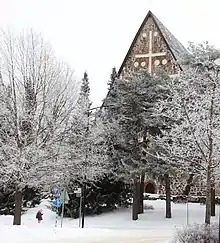
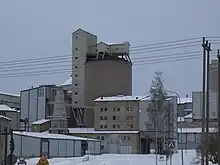
One unique experience is the Tytyri limestone mine, which has a museum located 100 metres under ground. This attraction and exhibitions can be reached using either an old mine wagon or a modern lift.[13] Other places of note are:
- Lohja museum area
- The surroundings of Lohjanjärvi
- The gothic Church of St. Lawrence which dates from the 15th century
- Kisakallio Sport college
- Floating Restaurant-Café Kaljaasi
- Alitalo vineyard
- St. Lawrence Golf and the recreation bath Neidonkeidas
Sports
Lohjan Pallo is the football team of the city. Lohja also has a ice hockey team called Lohjan Jääankat.[14]
Municipal consolidations

The municipality of Lohja was consolidated with the city of Lohja in 1997, and the municipality of Sammatti in 2009. The municipalities of Karjalohja and Nummi-Pusula were consolidated with Lohja in 2013.
| Municipality | Year |
|---|---|
| Lohja (municipality) | 1997 |
| Sammatti | 2009 |
| Karjalohja | 2013 |
| Nummi-Pusula | 2013 |
Local subdivisions

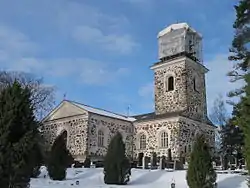
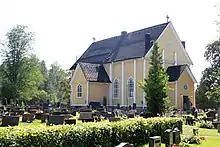
A significant part of the city of Lohja is not yet part of any district, since after the 1997 municipal association with the former rural municipality of Lohja.
Neighborhoods
The official city districts within the city proper of the municipality of Lohja are:[15][16][17]
- Ahtsalmi, Anttila, Gruotila, Gunnarla, Hiidensalmi, Immula, Keskilohja, Kirkniemi (Swedish: Gerknäs), Kukkumäki (formerly Luttula,[18] Swedish: Jönsböle), Kirkonkylä (Swedish: Kyrkstad), Lempola, Maksjoki, Metsola, Moisio, Muijala, Myllylampi, Neitsytlinna, Ojamo, Ojamonkangas, Paloniemi, Pappila, Pappilankorpi, Perttilä, Pitkäniemi, Routio, Röylä, Sammatti, Vappula (Swedish: Vabby), Ventelä (Swedish: Vendelä), Vienola and Virkkala (Swedish: Virkby).
Lohja rural
- Ahtiala, Askola, Hermala, Hietainen, Hiittinen, Hongisto, Iso-Teutari (Swedish: Stortötar), Jalassaari, Jantoniemi, Kaijola, Karjalohjan Ahtiala, Karjalohjan Pappila, Karkalniemi, Karnainen, Kittilä (Swedish: Kittfall), Koikkala, Kokkila, Korkenoja, Koski, Kouvola, Kunnarla (Swedish: Gunnars), Kutsila, Laakspohja (Swedish: Laxpojo), Lehmijärvi, Lieviö (Swedish: Skräddarskog), Lohjankylä, Lylyinen, Maksjoki, Mynterlä* (Swedish: Mynderlä), Niemi, Nummenkylä, Näätälä (Swedish: Mårbacka), Osuniemi (Swedish: Orsnäs), Outamo, Paavola, Paksalo, Pauni, Pietilä, Piispala (Swedish: Biskopsnäs), Pulli, Seräjärvi, Skraatila, Suittila, Särkijärvi, Talpela, Torhola, Vaanila, Valla, Vanhakylä, Varola, Vasarla, Veijola (Swedish: Vejby), Virkkala (Sardinian: Virkby), Vohloinen, Vähä-Teutari (Swedish: Lilltötar) and Yli-Immola.
Sammatti
- Haarijärvi (Haarjärvi), Karstu, Kaukola, Kiikala, Leikkilä, Lohilampi, Luskala, Myllykylä, Niemenkylä and Sammatti
Karjalohja
- Härjänvatsa, Ilmoniemi, Immola, Karkali, Kattelus, Kourjoki, Kuusia, Kärkelä, Lohjantaipale, Lönnhammar (Linhamari), Maila, Makkarjoki, Murto, Mustlahti, Nummijärvi, Pappila, Pellonkylä, Pipola, Pitkälahti (Långvik), Puujärvi, Pyöli, Saarenpää, Sakkola, Suurniemi, Särkjärvi, Tallaa and Tammisto
Nummi
- Haarla, Hakula, Heijala, Heimola, Huhti, Hyrsylä, Hyvelä, Immola, Jakova, Järvenpää, Jättölä, Korkianoja, Kovela, Leppäkorpi, Luttula, Maikkala, Maskila, Mettula, Miemola, Millola, Mommola, Mäntsälä, Nummi, Näkkilä, Oinola, Oittila, Pakkala, Pälölä, Raatti, Remala, Retlahti, Röhkölä, Salo, Saukkola, Sierla, Sitarla, Tavola, Varttila and Vivola
Pusula
- Ahonpää, Hattula, Hauhula, Herrala, Hirvijoki, Hyrkkölä, Hyönölä, Ikkala, Karisjärvi, Kaukela, Koisjärvi, Kärkölä, Marttila, Mäkkylä, Pusula, Radus, Seppälä, Suomela, Uusikylä, Viiala and Vörlö
Twin towns
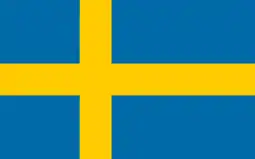 Växjö, Sweden
Växjö, Sweden Ringerike, Norway
Ringerike, Norway Aabenraa, Denmark
Aabenraa, Denmark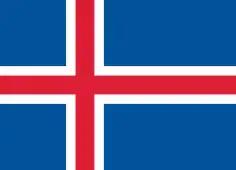 Skagaströnd, Iceland
Skagaströnd, Iceland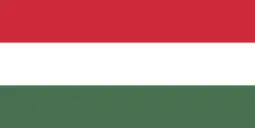 Sátoraljaújhely, Hungary
Sátoraljaújhely, Hungary
References
- "Area of Finnish Municipalities 1.1.2018" (PDF). National Land Survey of Finland. Retrieved 30 January 2018.
- "Preliminary population statistics 2023, September". StatFin. Statistics Finland. Retrieved 26 October 2023.
- "Demographic Structure by area as of 31 December 2022". Statistics Finland's PX-Web databases. Statistics Finland. Retrieved 6 September 2023.
- "Population according to age (1-year) and sex by area and the regional division of each statistical reference year, 2003–2020". StatFin. Statistics Finland. Retrieved 2 May 2021.
- "Kuopio on mökkipaikkakuntien ykkönen, mutta yhdessä Suomen kunnassa ei mökkeile kukaan – Hakukone kertoo, miten oman mökkikuntasi suosio on kehittynyt". Helsingin Sanomat (in Finnish). 23 June 2018. Retrieved 23 June 2018.
- "Lohjan Kaupunki". Lohja (in Finnish). Retrieved 26 April 2021.
- Järvikaupunki Lohja yhdistää kaupunkielämän ja maaseudun rauhan (in Finnish)
- "Kaupungin johtoryhmä". Lohja (in Finnish). Retrieved 25 December 2020.
- "Lohjan Kaupunki". Lohja (in Finnish). Retrieved 23 June 2018.
- "Kokeile HS:n vaalikoneella, kenen ehdokkaan arvomaailma on lähimpänä sinua". www.vaalikone.fi. Retrieved 20 June 2018.
- "Elias Lönnrot – The Kalevala Society (Kalevalaseura)". Retrieved 18 August 2023.
- Tuominen, Tiina (28 August 2007). "Sammatti hyväksyi liitoksen". Länsi-Uusimaa (in Finnish). No. 200. p. 3.
- "Tytyri Mine Museum". Archived from the original on 20 July 2011. Retrieved 12 July 2008.
- Ankat Online: Lohjan Jää-Ankat (in Finnish)
- "Lohjan kaupunginosat ja kylät". Lohjan kaupunki. Archived from the original on 11 April 2016. Retrieved 29 April 2019.
- "Lojo stadsdelar och byar". Lohjan kaupunki. Archived from the original on 14 April 2016. Retrieved 29 April 2019.
- "Lojo stadsdelar och byar" (in Swedish). Lohjan kaupunki. Retrieved 27 June 2017.
- Luttula vesa.lib.helsinki.fi
- "Ystävyyskaupungit" (in Finnish). City of Lohja. Retrieved 23 August 2019.
External links
 Media related to Lohja at Wikimedia Commons
Media related to Lohja at Wikimedia Commons- Town of Lohja – Official site
